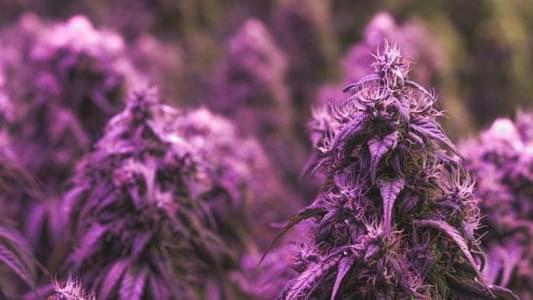
Purple Cannabis: Why You Should Care About Color
Published on 9/6/19
Grandaddy Purple. Purple Kush. Purple Haze.
If you've ever been into a dispensary you might have seen some of these strain names and noticed that the cannabis community has a fascination with the color purple. Purple strains, which are sometimes grouped together and called "Purps" are a relatively new genetic trend and a product of selective breeding that has resulted in purple marijuana being more common. There are all sorts of myths abound about royally-colored purple weed and while many of us are aware of them, most have wondered at one point or another: why is some weed purple?
What is Purple Weed?

The purple color in your bud doesn't indicate that your weed is different in any significant way. Much like some flower is dark green and some it lighter, dark purple bud is just a product of the plant's genetics and growing methods.
All cannabis has what are called 'flavonoids' in them - chemicals that, like terpenes or cannabinoids, have a range of psychoactive and therapeutic effects. Some flavonoids are anti-inflammatory, while others are antioxidants.
One of those flavonoids is called anthocyanin, which often is responsible for making some cannabis flowers take on a vibrant purple color. Anthocyanin is also present in a lot of plants and is one of the chemicals that make leaves change color in the fall.Strains with a deep purple color are generally high in anthocyanin and many growers have been known to bring it out in strains with purple in the name.
Flavonoids also play an important role in the way cannabis effects the user, though the precise mechanism by which it does so isn't always clear. The term entourage effect, coined in 1998 by two British researchers, refers to the way that the key compounds in cannabis (like THC and CBD) function in concert with all of the other chemicals in the plant. The effects produced by a strain are the result of the delicate and complex interplay of all of these chemicals.
How is Purple Weed Grown?

When it comes to the purps, how the bud is grown matters too. Purple weed plants don't necessarily always exhibit deep purple colors. Anthocyanin can also cause cannabis strains to have colors like deep red, rust-colored or blueberry blue. It all depends on how it's grown.
Since anthocyanin has a stronger impact in the fall or in cold temperatures when chlorophyll (the chemical that makes plants green) is produced in lower amounts. Some growers, hoping to bring out the purple hues, might lower the temperature while the plant is growing to bring it out more prominently. However, this can decrease yieldand THC concentration, so it's not something that growers do very often.
Where Did Purple Weed Come From?

The wider availability of purple cannabis is an example of how genetics can be traced back to some key strains that later get bred into new varieties. One of the first purple strains to hit the market with a splash was Grand Daddy Purple, which started showing up in the California medical market in the early 2000s. According to some, it owes some of its genetic lineage to Purple Urkle - another purple-colored strain that is thought to be a genetic variant of Mendocino Purp. Always take lineage history with a grain of salt, however; much of this was originally based on word-of-mouth and strain names are notoriously poor indicators of weed's actual lineage.
Is Purple Weed Any Different Than Green Weed?

You may have gotten high on purp weed without even noticing it. Indeed, there's nothing in purple weed that makes it any more unique than any other strain when it comes to effects. In general, there's nothing that makes it better or worse than any other type - it's just different. Also, the idea that purple weed is stronger than green weed is just a myth.
That said, purple strains could tell you some things about the cannabis' genetic lineage. Because purple tends to appear in strains grown in cooler temperature, weed that's purple often has genetics that trace back to shorter, bushier indica plants that originally grew in the cooler Asian climates. Purple Kush, for instance, is a classic indica strain that demonstrates this principle.

While it might not have a clear impact on the quality or strength of your smoke, not enough research has been conducted on purple cannabis to say otherwise. Some have theorized that the anthocyanin that makes your pot purple is the same thing that makes some fruits and vegetables purple. As a result, your weed might have some of the same antioxidant qualities that are found in those fruits.
But don't take the lack of proven benefits as a reason to discount purple bud or to see its color as irrelevant. The aesthetic look of the bud - its trimming, how tight or fluffy it is and its color - are all the result of choices made by the grower. Presentation matters, similarly to why you often pay more at a high-end restaurant. So next time you come across a sticky, purple bud, take some extra time to appreciate all the complex shades you can see in the bud. Even if you're not smoking a purple strain, be sure to check for other colors, as it's one of the many things that make every cannabis strain unique.
Have you tried purple weed before? Let us know your favorite purple strain in the comments below!
